FrameFlow gives you complete control over how and when you will be notified about events detected by your monitoring configuration. Notification triggers are one of the most powerful methods to define and control notifications. They help you easily denote the priority status of each alert generated. Each trigger type offers different options to alert you and each is covered here.
Navigate to the Settings section of your FrameFlow instance. From there, select "Notifications: Profiles" and hit the pencil icon to edit your profile. Under "Trigger On", you can select what notification trigger you'd like. Below, we explain how to use each type.
With the "All Events" trigger, the notification action will run every time an event is generated. In other words, it will trigger for success, warning, failure, and critical statuses. This option is best for writing to the FrameFlow event history and other cases where you want the notification action to run for every event.
 All Events Settings
All Events Settings
The "Success Only" trigger will only fire when success events are generated. It's used less frequently than the other trigger types but is useful in cases where you want to be alerted about the opposite of a normal check.
 Success Only Settings
Success Only Settings
The "Info Only" trigger type will only run the notification action when info events are generated. It's used to track notifications of low importance changes that might otherwise go unseen.
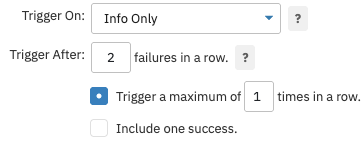 Info Only Settings
Info Only Settings
The "Warning Only" trigger type will only run the notification action when warning events are generated. It's good for triggering low-importance notification actions like sending emails to your first-line IT staff.
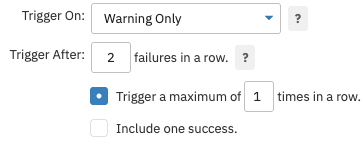 Warning Only Settings
Warning Only Settings
The "Error Only" trigger type will only run the notification action when error events are generated. It's good for triggering higher-level notification actions like notifying your second-line IT staff.
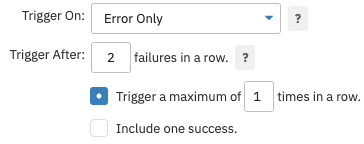 Error Only Settings
Error Only Settings
The "Critical Only" trigger type will only run the notification action when critical events are generated. It's best for urgent cases and is often used for sending SMS or voice alerts.
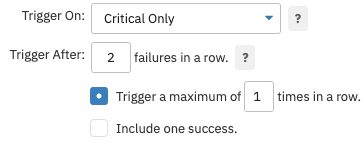 Critical Only Settings
Critical Only Settings
The "Non-Success" trigger type will run the notification action when anything other than success (Info, Warning, Error, and Critical) is generated.
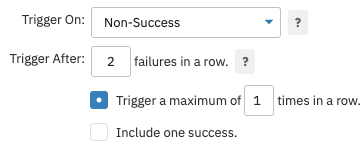 Info, Warning, Error, & Critical Settings
Info, Warning, Error, & Critical Settings
The "Warning, Error, and Critical" trigger type will only run the notification action when anything other than success or info is generated.
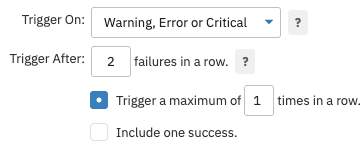 Warning, Error, and Critical Settings
Warning, Error, and Critical Settings
The "Error and Critical" trigger type will fire for error and critical events but it will not fire for warnings or successes.
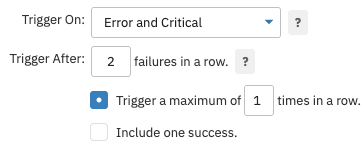 Error and Critical Settings
Error and Critical Settings
The "State Change Style - Pass/Fail" trigger type will fire once when an event monitor run switches from success to any other status. It will trigger again when the event monitor goes back to success. In between, it will not trigger. As an example, imagine the following sequence of events: Success, Warning, Warning, Failure, Success, Success. This trigger style would fire on the first warning and then on the following success but not for any of the other events.
 State Change Settings
State Change Settings
The "State Change Style - By Status" trigger type will fire once when an event monitor run switches from any status to any other status. It will not trigger for repeated events with the same status as the previous one. As an example, imagine the following sequence of events: Success, Warning, Warning, Failure, Failure, Critical, Success, Success. This trigger style would fire on the first warning, the first failure, the critical event, and then on the following success but not for any of the other events.
 More State Change Settings
More State Change Settings
As with the "by status" trigger type, the "State Change Style - By Condition" type will fire once when an event monitor switches from any status to any other status but it will also trigger if the status stays the same but one or more of the alert conditions changed.
For example, consider a System Health Event Monitor that is checking disk space and CPU. If the CPU usage reaches warning level this style will trigger when the status switches from success to warning. If the CPU status remains at warning level it will not trigger on subsequent runs. However, if the status for a disk reaches warning level while the CPU is still at warning level the notification action will be triggered.
 State Change by Condition Settings
State Change by Condition Settings
In this tutorial, we showed you all the different notification triggers available to you with FrameFlow. Now that you know the differences, you can begin personalizing your monitoring and alerting configurations more than ever before. Make sure to keep an eye on the Features page in the future so you can read up on all the tips and tricks that we post there.
More IT Monitoring Features